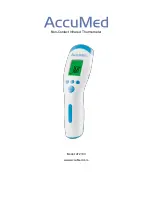
- -
10
4.
PROBES
AND
MEASUREMENTS
The instrument works with thermocouple probes of type K, J, T, or E.
See chapter 3 for the selection of the type of probe.
The contacts of the thermocouple probe connector are polarized. They must be inserted on the
standard miniature socket located on the instrument in the correct direction. These probes are
usually marked with a "+" and "–" sign.
The user can choose the unit of measurement for display of temperature: °C and °F.
The Thermometer
HD2328.0
has two inputs: the temperature for input "A" (see description of the
inputs) is displayed in the main line: the temperature for input "B" is displayed in the secondary
line. When the "A-B" function is enabled, the relevant differential temperature is displayed in the
secondary line.
If two probes are used, they must be the same type of thermocouple.
4.1
T
EMPERATURE
M
EASUREMENT
In all versions the thermocouple hot junction is housed in the end part of the probe.
The response time for the measurement of the temperature in
air
is greatly reduced if the air is
moving. If the air is still, stir the probe. The response times are longer than those for liquid
measurements.
The temperature measured by
immersion
is carried out by inserting the probe in the liquid, in the
oven where you wish to perform the measurement; the hot junction is housed in the end part of the
probe.
In the temperature measured by
penetration
the probe tip must be inserted into the material; the hot
junction is housed in the end part of the probe.
NOTE:
when measuring the temperature on frozen blocks it is convenient to use a mechanical tool
to bore a cavity in which to insert the tip probe.
In order to perform a correct
contact
measurement, the measurement surface must be even and
smooth, and the probe must be perpendicular to the measurement plane.
So as to obtain the correct measurement, the insertion of a drop of oil or heat-conductive
paste between the surface and the probe is useful (do not use water or solvents). This method
also improves the response time.
4.2
C
ALIBRATION OF THE INSTRUMENT ON LINE WITH THE PROBE
(
S
)
To calibrate the probes correctly, a knowledge of and abiding by the physical phenomena on which
the measurement is based is fundamental: this is the reason why it is recommended to abide by what
is reported below carefully, and only to perform new calibrations if technically proficient and using
the suitable equipment.
The instrument is provided with the only
FACT
(factory) calibration.
The user is also able to perform a
USER calibration
of insprobe.
Содержание HD2328
Страница 2: ... 2 Thermocouple Thermometer HD2328 ...






































